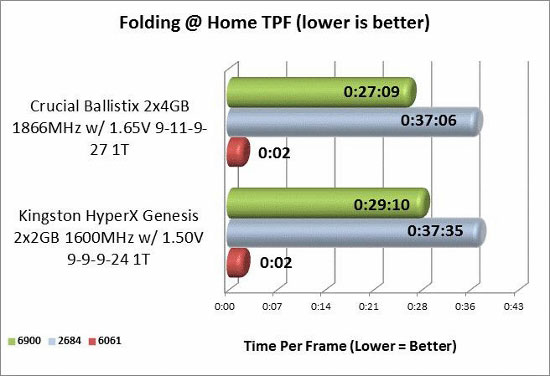Crucial Ballistix 8GB DDR3 2000MHz CL9 Memory Kit Review
Folding@Home scientific simulation
Folding@Home (http://folding.stanford.edu/) is a distributed computing project, which means people throughout the world download the Folding@Home client software and run it. When combined, the processing power of the Folding@Home project is one of the worlds most powerful supercomputers. The project is used to study protein folding, misfolding, and related diseases, giving researchers the tools to better understand diseases such as Alzheimer’s, ALS, Mad Cow (BSE), CJD, Huntington’s, Parkinson’s disease, and many Cancers. Anyone can run the Folding@Home client software and use their spare CPU and GPU power to contribute to a good cause. After the client software finishes a molecular simulation, called a Work Unit (WU), the donor receives points based on the amount of processing power required to run the WU and how quickly the WU was completed. Many Folding@Home contributors join together to form teams, creating a lot of friendly competition between teams and team members to compile the most points in the project.
To benchmark Folding@Home we are using an application developed by a group of Folding@Home contributors, led by a user named musky. Muskys benchmark uses a particular set of work units to allow a measurable, consistent comparison between benchmark runs. Since our CPU is a 4 core, 8 thread CPU with hyperthreading, we will be benchmarking multithreaded SMP units as well as large project 2684 and 6900 bigadv work units. Bigadv (which stands for big advanced) units are designed for CPUs that can handle 8 simultaneous threads. Bigadv units are larger than standard SMP units so they can effectively use a multithreaded CPUs processing power to complete the scientific work as quickly as possible and produce the most points per day for the donor.

The 6061 is a standard multithreaded SMP work unit and its memory requirements are relatively low. Thus, it does not show a significant gain due to additional memory bandwidth. The 2684 is a bigadv work unit, and is notorious for heavily using CPU power. It appears the 2684, like the 6061, is more of a pure CPU test, and shows only minor gains.
The 6900 bigadv work unit, however, is a project that heavily uses both CPU and memory, and thus the bandwidth of the BallistiX kit finally translates into a noticeable 7% real-world speed improvement. Several of the most recent work units released by the Pande Group at Stanford demonstrate characteristics similar to the 6900 units, so it would seem a bigadv-capable Folding@Home PC would show a definite benefit to using faster DDR3. We were able to squeeze a few more seconds off our TPF by tightening timings on this RAM as well. Our results from our overclocking tests can be found later in this article after the gaming tests.
With the computation-heavy tasks completed, lets see how the BallistiX fare under a gaming workload.

Comments are closed.